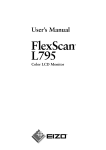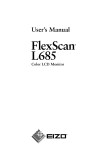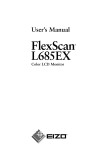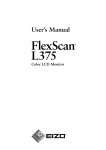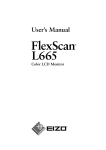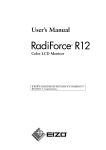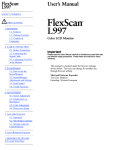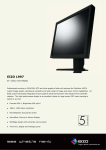Download Eizo L695 User`s manual
Transcript
User’s Manual Color LCD Monitor English SAFETY SYMBOLS This manual uses the safety symbols below. They denote critical information. Please read them carefully. WARNING Failure to abide by the information in a WARNING may result in serious injury and can be life threatening. CAUTION Failure to abide by the information in a CAUTION may result in moderate injury and/or property or product damage. Indicates a prohibited action. Indicates to ground for safety. Copyright© 2003 EIZO NANAO CORPORATION. All rights reserved. No part of this manual may be reproduced, stored in a retrieval system, or transmitted, in any form or by any means, electronic, mechanical, or otherwise, without the prior written permission of EIZO NANAO CORPORATION. EIZO NANAO CORPORATION is under no obligation to hold any submitted material or information confidential unless prior arrangements are made pursuant to EIZO NANAO CORPORATION's receipt of said information. Although every effort has been made to ensure that this manual provides up-to-date information, please note that EIZO monitor specifications are subject to change without notice. ENERGY STAR is a U.S. registered mark. Apple and Macintosh are registered trademarks of Apple Computer, Inc. VGA is a registered trademark of International Business Machines Corporation. DPMS is a trademark and VESA is a registered trademark of Video Electronics Standards Association. Windows is a registered trademark of Microsoft Corporation. PowerManager and i·Sound are trademarks of EIZO NANAO CORPORATION. FlexScan, ScreenManager and EIZO are registered trademarks of EIZO NANAO CORPORATION. As an ENERGY STAR® Partner, EIZO NANAO CORPORATION has determined that this product meets the ENERGY STAR guidelines for energy efficiency. 2 English TABLE OF CONTENTS PRECAUTIONS ...................................................................................... 4 1. INTRODUCTION .................................................................................... 9 1-1. Features .......................................................................................................9 1-2. Package Contents.........................................................................................9 1-3. Controls & Connectors .............................................................................10 2. CABLE CONNECTION ........................................................................ 12 2-1. Before Connecting .....................................................................................12 2-2. Connecting the Signal Cable ......................................................................13 2-3. Connecting Two PCs to the Monitor .........................................................15 3. ScreenManager ................................................................................... 17 3-1. How to use the ScreenManager .................................................................17 3-2. ScreenManager Adjustments and Settings..................................................18 3-3. Useful Functions ........................................................................................19 4. ADJUSTMENT ..................................................................................... 21 4-1. 4-2. 4-3. 4-4. Screen Adjustment .....................................................................................21 Displaying a Low Resolutions ...................................................................25 Color Adjustment ......................................................................................27 Power-save Setup .......................................................................................29 5. ActiveShot Function ........................................................................... 31 5-1. Operation ..................................................................................................31 5-2. Sub Window Settings .................................................................................32 5-3. Settings using the Control Buttons.............................................................34 6. ActiveRotation Function .................................................................... 35 7. Recommended Functions.................................................................. 37 8. ATTACHING AN ARM .......................................................................... 38 9. TROUBLESHOOTING.......................................................................... 40 10. CLEANING ......................................................................................... 44 11. SPECIFICATIONS .............................................................................. 45 12. GLOSSARY........................................................................................ 48 APPENDIX/ANHANG/ANNEXE .................................................................. i TABLE OF CONTENTS 3 English PRECAUTIONS IMPORTANT! • This product has been adjusted specifically for use in the region to which it was originally shipped. If operated outside the region to which it was originally shipped, the product may not perform as stated in the specifications. • To ensure personal safety and proper maintenance, please read this section and the caution statements on the unit (refer to the figure below). [Location of the Caution Statements] WARNING If the unit begins to emit smoke, smells like something is burning, or makes strange noises, disconnect all power connections immediately and contact your dealer for advice. Attempting to use a malfunctioning unit may result in fire, electric shock, or equipment damage. Do not open the cabinet or modify the unit. Opening the cabinet or modifying the unit may result in fire, electric shock, or burn. Refer all servicing to qualified service personnel. Do not attempt to service this product yourself as opening or removing covers may result in fire, electric shock, or equipment damage. 4 PRECAUTIONS English WARNING Keep small objects or liquids away from the unit. Small objects accidentally falling through the ventilation slots into the cabinet or spillage into the cabinet may result in fire, electric shock, or equipment damage. If an object or liquid falls/spills into the cabinet, unplug the unit immediately. Have the unit checked by a qualified service engineer before using it again. Place the unit at the strong and stable place. A unit placed on an inadequate surface may fall and result in injury or equipment damage. If the unit falls, disconnect the power immediately and ask your dealer for advice. Do not continue using a damaged unit. Using a damaged unit may result in fire or electric shock. OK Set the unit in an appropriate location. Not doing so may result in fire, electric shock, or equipment damage. * Do not place outdoors. * Do not place in the transportation system (ship, aircraft, trains, automobiles, etc.) * Do not place in a dusty or humid environment. * Do not place in a location where the steam comes directly on the screen. * Do not place near heat generating devices or a humidifier. To avoid danger of suffocation, keep the plastic packing bags away from babies and children. Use the enclosed power cord and connect to the standard power outlet of your country. Be sure to remain within the rated voltage of the power cord. Not doing so may result in fire or electric shock. To disconnect the power cord, grasp the plug firmly and pull. Tugging on the cord may damage and result in fire or electric shock. OK PRECAUTIONS 5 English WARNING The equipment must be connected to a grounded main outlet. Not doing so may result in fire or electric shock. Use the correct voltage. * The unit is designed for use with a specific voltage only. Connection to another voltage than specified in this User’s Manual may cause fire, electric shock, or equipment damage. * Do not overload your power circuit, as this may result in fire or electric shock. Handle the power cord with care. * Do not place the cord underneath the unit or other heavy objects. * Do not pull on or tie the cord. If the power cord becomes damaged, stop using it. Use of a damaged cord may result in fire or electric shock. Never touch the plug and power cord if it begins to thunder. Touching them may result in electric shock. When attaching an arm stand, please refer to the user’s manual of the arm stand and install the unit securely with the enclosed screws. Not doing so may cause the unit to become unattached, which may result in injury or equipment damage. When the unit is dropped, please ask your dealer for advice. Do not continue using a damaged unit. Using a damaged unit may result in fire or electric shock. When reattaching the tilt stand, please use the same screws and tighten them securely. Do not touch a damaged LCD panel directly with bare hands. The liquid crystal that may leak from the panel is poisonous if it enters the eyes or mouth. If any part of the skin or body comes in direct contact with the panel, please wash thoroughly. If some physical symptoms result, please consult your doctor. Follow local regulation or laws for safe disposal. The backlight of the LCD panel contains mercury. 6 PRECAUTIONS English CAUTION Handle with care when carrying the unit. Disconnect the power cord and cables when moving the unit. Moving the unit with the cord attached is dangerous. It may result in injury. When handling the unit, grip the bottom of the unit firmly with both hands ensuring the panel faces outward before lifting. Dropping the unit may result in injury or equipment damage. OK Do not block the ventilation slots on the cabinet. * Do not place any objects on the ventilation slots. * Do not install the unit in a closed space. * Do not use the unit laid down or upside down. Blocking the ventilation slots prevents proper airflow and may result in fire, electric shock, or equipment damage. Do not touch the plug with wet hands. Doing so may result in electrical shock. Use an easily accessible power outlet. This will ensure that you can disconnect the power quickly in case of a problem. Periodically clean the area around the plug. Dust, water, or oil on the plug may result in fire. Unplug the unit before cleaning it. Cleaning the unit while it is plugged into a power outlet may result in electric shock. If you plan to leave the unit unused for an extended period, disconnect the power cord from the wall socket after turning off the power switch for the safety and the power conservation. PRECAUTIONS 7 English LCD Panel In order to suppress the luminosity change by long-term use and to maintain the stable luminosity, use of a monitor in lower brightness is recommended. The screen may have defective pixels. These pixels may appear as slightly light or dark area on the screen. This is due to the characteristics of the panel itself, and not the product. The backlight of the LCD panel has a fixed life span. When the screen becomes dark or begins to flicker, please contact your dealer. Do not press on the panel or edge of the frame strongly, as this may result in damage to the screen. There will be prints left on the screen if the pressed image is dark or black. If pressure is repeatedly applied to the screen, it may deteriorate or damage your LCD panel. Leave the screen white to decrease the prints. Do not scratch or press on the panel with any sharp objects, such as a pencil or pen as this may result in damage to the panel. Do not attempt to brush with tissues as this may scratch the LCD panel. 8 PRECAUTIONS English 1. INTRODUCTION Thank you very much for choosing an EIZO Color Monitor. 1-1. Features • Dual inputs compliant • DVI (p. 48) Digital input (TMDS (p. 49)) compliant • [Horizontal scanning frequency] Analog: 30 - 82 kHz, Digital: 30 - 81 kHz [Vertical scanning frequency] Analog: 49 - 86 Hz (1280 x 1024 ~ 76 Hz) Digital: 59 - 61 Hz (VGA text: 70 Hz) [Resolution] 1280 dots x 1024 lines • ActiveShot (Picture in Picture) function incorporated (p. 31) • ActiveRotation (changing the display orientation to portrait) function incorporated (p. 35) • Smoothing function incorporated for the adjustment of an enlarged image (p. 26) • Auto Adjustment compliant and original “Picture Adjustment Program” software included • ColorManagement function incorporated (p. 27) • Support to sRGB (p. 49) standard • The height adjustable stand incorporated • Ultra slim bezel incorporated 1-2. Package Contents Please contact your local dealer for assistance if any of the listed items are missing or damaged. • LCD Monitor • EIZO LCD Utility Disk • Power Cord • User’s Manual • Signal Cable (FD-C16) • Quick Reference • Signal Cable (MD-C100) • LIMITED WARRANTY • EIZO USB Cable (MD-C93) NOTE • Please retain the packing materials for future transference. • The EIZO USB cable is used when using the software, “ActiveRotation” application (for Windows) in the EIZO LCD Utility Disk. (Refer to the readme.txt in the EIZO LCD Utility Disk for the details.) 1. INTRODUCTION 9 English 1-3. Controls & Connectors Front (2) (1) Control Panel SIGNAL 1-2 AUTO ENTER (3) (4) (5) (6) (1) (2) (3) (4) (5) (6) (7) (8) (9) (7) (8) (9) ® ScreenManager Main Power Button Input Signal Selection Button PinP (Picture in Picture) Button Auto Adjustment Button Enter Button Control Buttons (Left, Down, Up, Right) *1 Power Button Power Indicator*2 Blue Operation Yellow Power saving Flashing yellow (2 times for each) Power save mode Digital only Flashing yellow slowly Power is off (Main power is on) Off Power off *1 These buttons are changed to Up, Left, Right, Down in case of selecting “Portrait(HW/SW)” for <Orientation> of ScreenManager <Others> (p. 35) *2 Regarding the power indicator for the off timer, see p. 19. 10 1. INTRODUCTION English Rear (10) (11) (12) Bottom (13) (14) (15) (10) (11) (12) (13) (14) (15) (16) *3 *4 *5 (16) Height Adjustable Stand (Detachable)*3 Power Terminal Covers for the Optional peripheral Security Lock Slot*4 D-Sub mini 15 pin Input Connector (SIGNAL 1) DVI-I Input Connector (SIGNAL 2) USB Port (1 Upstream) *5 Power Connector The LCD monitor has the capability of the Portrait/Landscape display. (The panel pivots in the clockwise direction 90°), see p. 35. The LCD monitor can be used with an optional arm by removing the stand, see p. 38. Allows for connection of a security cable. This lock supports Kensington’s MicroSaver security system. For further information, please consult’ Kensington Technology Group 2855 Campus Drive, San Mateo, CA 94403 USA Tel.: 800-650-4242, x3348, Intl: 650-572-2700, x3348 Fax: 650-572-9675 http://www.kensington.com USB upstream port is used when using the “ActiveRotation” application (for Windows) in the EIZO LCD Utility Disk (refer to the Readme file). 1. INTRODUCTION 11 English 2. CABLE CONNECTION 2-1. Before Connecting Before connecting your monitor to the PC, change the display screen settings (resolution p. 49) and frequency) in accordance with the charts below. NOTE • When your computer and display support VESA DDC, the suitable resolution and the refresh rate are set by just plugging your display into the computer without any manual settings. Analog Input Resolution Frequency 640 × 480 ~ 85 Hz 640 × 480 67 Hz Dot Clock Remarks 140 MHz (Max.) Apple Macintosh VGA, VESA 720 × 400 70 Hz 800 × 600 ~ 85 Hz VESA VGA TEXT 832 × 624 75 Hz Apple Macintosh 1024 × 768 ~ 85 Hz VESA 1152 × 864 75 Hz VESA 1152 × 870 75 Hz Apple Macintosh 1152 × 900 ~ 76 Hz SUN WS 1280 × 960 60 Hz VESA 1280 × 960 75 Hz Apple Macintosh 1280 × 1024 67 Hz SUN WS 1280 × 1024 ~ 75 Hz VESA Digital Input Only the following resolutions with frequency can be displayed on this model. 12 Resolution Frequency 640 × 480 60 Hz 720 × 400 70 Hz Dot Clock Remarks 120 MHz (Max.) VGA TEXT VGA 800 × 600 60 Hz 1024 × 768 60 Hz VESA 1280 × 1024 60 Hz VESA 2. CABLE CONNECTION VESA English 2-2. Connecting the Signal Cable NOTE • Be sure that the Power buttons of both the PC and the monitor are OFF. 1. Plug the signal cable into the connector at the rear of the monitor and the other end of the cable into the video connector on the PC. After connecting, secure the connection with the screw-in fasteners. Analog Input D-Sub mini 15 pin DVI MD-C100 Signal Cable FD-C16 or MD-C100 enclosed FD-C16 or MD-C100 enclosed + Adapter* Power Cord FD-C16 Connector of PC PC Video Output Connector D-Sub mini 15 pin • Standard graphics card Video Output Connector D-Sub 15 pin • Macintosh • Macintosh G3 (Blue & White) / Power Mac G4 (VGA) *Macintosh Adapter (Optional) Digital Input DVI FD-C39 (Optional) Signal Cable FD-C39 (Optional) Power Cord Connector of PC Video Output Connector DVI PC • Power Mac G4 (DVI) • Digital graphics board NOTE • The monitor is not compatible with a Power Mac G4/G4 Cube ADC (Apple Display Connector) 2. CABLE CONNECTION 13 English 2. Plug the power cord into the power connector on the rear of the monitor. 3. Lead the power cord and signal cable into the cable holder at rear of the monitor. NOTE • The cables are recommended to lead with slight sag for the smooth motion of the stand and the Portrait/Landscape display. Cable Holder 4. Plug the other end of the power cord into a power outlet. WARNING Use the enclosed power cord and connect to the standard power outlet of your country. Be sure to remain within the rated voltage of the power cord. Not doing so may result in fire or electric shock. The equipment must be connected to a grounded main outlet. Not doing so may result in fire or electric shock. 14 2. CABLE CONNECTION English 5. Turn on the monitor's main power and then switch on the PC's power. The monitor’s power indicator will light up (blue). If an image does not appear, refer to the “TROUBLESHOOTING” (p. 40) for advice. Whenever finished, turn off the PC and the monitor. 6. When using the monitor in portrait style, refer to the “6. ActiveRotation Function” (p. 35). NOTE • When turning on the monitor, the kind of the input signal (Signal1/ Analog or Signal 2/Analog or Digital) is displayed for a few seconds on the right top corner of the screen. • Adjust brightness of the screen depending on the brightness of your environment. • Be sure to take adequate rests. A 10-minute rest period each hour is suggested. 2-3. Connecting Two PCs to the Monitor Two PCs can be connected to the monitor through the Signal 1 and the Signal 2 on the back of the monitor. Connecting Examples Signal 1 Signal 2 PC 1 PC 2 (Ex.1) Analog D-Sub Signal Cable mini 15 (MD-C100 enclosed) pin Signal Cable (FD-C16 enclosed) D-Sub mini 15 pin Analog (Ex.2) Analog D-Sub Signal Cable mini 15 (MD-C100 enclosed) pin Signal Cable (FD-C39 Optional) DVI Digital 2. CABLE CONNECTION 15 English Selecting the Active Input The Input signal selection button on the control panel can be used to select either Signal 1 or Signal 2 as the active input at any time. Every time the button is pressed, the input changes. When switching the signal, the kind of the input signal (Signal1/ Analog or Signal 2/Analog or Digital) is displayed for a few seconds on the right top corner of the screen. Input Signal Selection Button SIGNAL 1-2 AUTO ENTER NOTE • When using the ActiveShot function (p. 31), pressing the Input signal selection button switches the image of the Main window and the Sub window. The Priority Input Signal This function is used to select which PC will have priority to control the monitor when utilizing two PCs. The monitor constantly checks the input signals and switches automatically in accordance with the “Input Priority” setting (see table below). Once a priority is set, whenever a change of signal is detected at the selected input, the monitor will switch the input to that signal. In the case of only one signal being present at either input, the monitor automatically detects and displays that signal. Priority Setting Performance If signals from both inputs are present, the monitor gives preference to Signal 1 in the following cases. Signal 1 • When the power of the monitor is turned ON • When the signal input to Signal 1 is changed even if active input was Signal 2. If signals from both inputs are present, the monitor gives preference to Signal 2 in the following cases. Signal 2 • When the power of the monitor is turned ON • When the signal input to Signal 2 is changed even if active input was Signal 1. Manual The monitor will not detect signals automatically in this mode. Select the active input by pressing the input signal selection button on the monitor’s control panel. NOTE • About Power saving mode When the Signal 1 or Signal 2 is selected, the power saving mode of the monitor operates only if both PCs are in power saving mode. 16 2. CABLE CONNECTION English 3. ScreenManager 3-1. How to use the ScreenManager Control Buttons Left, Down, Up, Right SIGNAL 1-2 AUTO ENTER Auto Adjustment Enter button button 1. Entering the ScreenManager Press the Enter button once to display the main menu of the ScreenManager. [Main Menu] 2. Making Adjustments and Settings (1) Select the desired sub menu icon using the Control buttons and press the Enter button. The sub menu appears. (2) Use the Control buttons to select the desired setting icon and press the Enter button. The setting menu appears. (3) Use the Control buttons to make all required adjustments and press the Enter button to save the settings. 3. Exiting the ScreenManager (1) To return to the main menu, select the <Return> icon or press the down button twice, followed by the Enter button. (2) To exit the ScreenManageru, select the <Exit> icon or press the down button twice, followed by the Enter button. NOTE • Double clicking the Enter button at any time also exits the ScreenManager menu. 3. ScreenManager 17 English 3-2. ScreenManager Adjustments and Settings. The following table shows all the ScreenManager’s adjustment and setting menus. “*” indicates adjustments of analog input only and “**” indicates digital input only. Main menu Screen Sub menu Reference Clock * Phase * 4-1. Screen Adjustment (p. 21) Position Resolution Range Adjustment * Smoothing * Signal Filter ColorManagement Color Mode Custom Mode 4-3. Color Adjustment (p. 27) Brightness/ Contrast Temperature Saturation Hue Gain Reset sRGB Brightness Picture in Picture Standard 5. ActiveShot Function (p. 31) PowerManager DVI DMPM ** VESA DPMS * EIZO MPMS Screen Size * Clip Others 4-4. Power-save Setup (p. 29) 4-2. Displaying a Low Resolutions (p. 25) Border Intensity Input Priority Select the priority input signal. (p. 16) Off Timer Set the monitor’s off timer to on or off. (p. 19) Beep Set the monitor’s beeper to on or off. (p. 46) Menu Settings Menu Size Change the size of the menu. Menu Position Adjust the menu position Menu Off Timer Set the menu displaying time. Translucent Set the transparency of the background. Orientation Power Indicator Reset 6. ActiveRotation Function (p. 35) Make non-light for blue lighting when the screen is displayed. Return to the factory default settings. (p. 46) Information Information Review the ScreenManager’s settings, model name, serial number and usage *1 time . Language English, German, French, Spanish, Italian, Swedish and Japanese Select the ScreenManager’s language. *1 Due to the inspection on the factory, the usage time may not “0 hour” at shipping. 18 3. ScreenManager English 3-3. Useful Functions Adjustment Lock Use the “Adjustment Lock” function to prevent any accidental changes. Locked function • Auto adjustment button adjustments and settings in the ScreenManager. • Auto Adjustment Button • PinP Button Unlocked function • Adjustment of contrast and brightness by the control buttons. • Input Signal Selection Button [To lock] (1) Switch off the monitor’s power by the power button on the control panel. (2) Press on the Auto adjustment button while switching on the monitor’s power. [To unlock] (1) Switch off the monitor’s power by the power button on the control panel. (2) Hold down the Auto adjustment button once again and turn the power back on. Off Timer The off timer function causes the monitor to automatically enter a power off state after a predetermined amount of time has lapsed. This function was created to reduce afterimage (p. 48) characteristics that are particular to LCD monitors when the monitor screen is left on for a long period without use. [Procedure] (1) Select <Off Timer> in the ScreenManager “Others” menu. (2) Select “Enable” and press the right and left buttons to adjust the “On Period” (1 to 23 hours). [Off timer system] PC On Period (1H - 23H) *1 Monitor Operation Last 15 min. in "On period" Advance Notice "On period" expired Power off Power Indicator Blue *1 Blue Flashing Flashing yellow slowly Advance notice (Power indicator flashing blue) will be given 15 minutes before the monitor automatically enters the “Power Off” mode. To delay entering the “Power Off” mode, press the power button during the advance notice period. The monitor will continue to operate for an additional 90 minutes. [Power Resumption Procedure] Press the power button to return to a normal screen. NOTE • The off timer function works while the PowerManager is active, but there is no advance notice before the monitor’s power is switched off. 3. ScreenManager 19 English EIZO Logo Appearing Function When switching on the power button on the control panel, the EIZO logo is displayed for a while. If you desire to display or undisplay this logo, use this function. (Default is logo appearing.) [To undisplay] (1) Switch off the monitor’s power by the Power button on the control panel. (2) Hold down the Enter button once again and turn the power back on. [To display again] (1) Switch off the monitor’s power by the Power button. (2) Hold down the Enter button once again and turn the power back on. 20 3. ScreenManager English 4. ADJUSTMENT 4-1. Screen Adjustment NOTE • Allow the LCD monitor to stabilize for at least 20 minutes before making image adjustments. • When using the ActiveShot function (p. 31), adjust the screen of each signal in advance. When connecting the DVI cable for digital input, see p. 24. Analog Input Screen adjustments for the LCD monitor should be used in suppressing screen flickering and also for adjusting the screen to its proper position. There is only one correct position for each display mode. It is also recommended to use the ScreenManager function when first installing the display or whenever changing the system. For convenience, an easy set-up Program installed on the utility disk to assist in the set-up procedure is provided. Adjustment Procedure 1. Press the Auto adjustment button on the control panel. The message “Your setting will be lost, if you press again now.” appears and remains on the screen for 5 seconds. While the message is on the screen, press the Auto adjustment button again to automatically adjust the clock, phase, screen position and resolution. If you do not wish to do adjust the screen, do not press the Auto adjustment button again. NOTE • The Auto sizing function is intended for use on the Macintosh and on AT-compatible PC running Windows. It may not work properly in either of the following cases. When running an AT-compatible PC on MS-DOS (Not windows). The background color for the “wall paper” or “desktop” pattern is set to black. If the appropriate screen cannot be made by using the Auto adjustment button, adjust the screen through the following procedures. If the appropriate screen can be made, proceed to step 4. 2. Install the “Screen adjustment program” Having read the “Readme.txt” file, install and run the “Screen adjustment program” in the enclosed EIZO LCD utility disk. Step by step adjustment is provided by the wizard guide. (If using the Windows, the program can be directly run from the menu screen of the EIZO LCD utility disk.) 4. ADJUSTMENT 21 English NOTE • If the user’s operating system has no utility disk (e.g. OS/2), we recommend setting the desktop pattern to that as shown in the diagram on the following page. 3. Adjust by using <Screen> menu in the ScreenManager. (1) Vertical bars appear on the screen → Use the <Clock> (p. 48) adjustment. Select the “Clock” and eliminate the vertical bars by using the right and left of the control buttons. Do not continuously press the control buttons, as the adjustment value will change quickly and make it difficult to locate the most suitable adjustment point. If the horizontal flickering, blur or bars appear, proceed to “Phase” adjustment as follows. NOTE • When adjusting the <Clock>, the horizontal screen size will also change. (2) Horizontal flickering, blurring or bars appear on the screen. → Use the <Phase> (p. 48) adjustment. Select the <Phase> and eliminate the horizontal flickering, blurring or bars by using the right and left buttons. NOTE • Horizontal bars may not completely disappear from the screen depending on the PC. 22 4. ADJUSTMENT English (3) The screen position is not incorrect. Use the <Position> adjustment. → The correct displayed position of the monitor is decided because the number and the position of the pixels are fixed. The <Position> adjustment moves the image to the correct position. Select <Position> and adjust the position by using the Up, Down, Right and Left buttons. If vertical bars of distortion appear after finishing the <Position> adjustment, return to <Clock> adjustment and repeat the previously explained adjustment procedure (“Clock” → “Phase” → “Position”) (4) Screen image is smaller or larger than the actual screen images. → Use the <Resolution> adjustment. Adjustment is needed when the input signal resolution and the resolution now being displayed are different. Select <Resolution> and confirm if the resolution now being displayed is the same as the input resolution. If it is not, adjust the vertical resolution using the up and down button and adjust the horizontal resolution using the right and left buttons. Smaller than the actual screen images. Adjusted to actual screen Larger than the actual screen images. 4. ADJUSTMENT 23 English 4. Adjust the output signal range (Dynamic Range) of the signal. → Use the <Range Adjustment> (p. 49). This controls the level of output signal range to display the whole color gradation (256 colors). [Procedure 1] Press the Auto adjustment button on the control panel while displaying the <Range Adjustment> menu to automatically adjust the range. The screen blanks for a moment, and adjusts the color range to display the whole color gradation of the current output signal. [Procedure 2] Pressing Auto adjustment button while displaying the contrast/brightness adjustment screen (appeared by pressing the control buttons directly) adjusts the range automatically. (Contrast and Brightness will not be adjusted.) Digital Input The monitor displays the digital input image correctly based on its pre-setting data. However, if the image position is not correct or larger than the actual image screen, please adjust the following adjustment items using the “Screen” menu of the ScreenManager. 1. The screen position is incorrect. → Use the <Position> adjustment. See p. 23. 2. Screen image is smaller or larger than the actual screen images. → Use the <Resolution> adjustment. See p. 23. 24 4. ADJUSTMENT English 4-2. Displaying a Low Resolutions The lower resolutions are enlarged to full screen automatically. Using the <Screen Size> function in the <Others> menu enables to change the screen size. 1. Change the screen size when displaying a low resolution. → Select the <Screen Size>. Select the <Screen Size> in the <Others> menu and select the screen size by using the up and down buttons. Menu Function Full Displays the picture on the screen in full, irrespective of the picture’s resolution. Since the vertical resolution and the horizontal resolution are enlarged at different rates, some images may appear distorted. Enlarged Displays the picture on the screen in full, irrespective of the picture’s resolution. Since the vertical resolution and horizontal resolution are enlarged at same rates, some horizontal or vertical image may disappear. Normal Displays the picture at the actual Screen resolution. Example: Displaying1024 x 768 Full (Default) Enlarged Normal (1280×1024) (1280×960) (1024×768) NOTE • When using the ActiveShot (p. 31) or ActiveRotation (p. 35) function, the screen size cannot be enlarged. • When displaying the Sub window of ActiveShot function after setting “Enlarged” or “Normal”, the screen image of the Main window is displayed in “Full“ mode. 4. ADJUSTMENT 25 English 2. Smooth the blurred texts of the enlarged screen. → Switch the <Smoothing> setting. Select the suitable level from 1 – 5 (Soft – Sharp). Select <Smoothing> in the <Screen> menu and adjust by using the right and left buttons. NOTE • <Smoothing> is disabled when the screen is displayed in the following resolutions. *1280 x 1024 *The image size is doubled both in horizontally and vertically to (i.e. 1280 x 960 enlarged from 640 x 480) provide clear focus which does not require this function. 3. Set the brightness of the black area surrounding the displayed image. → Set the <Border Intensity>. In the <Enlarge> mode or <Full Screen> mode, the outer area (border) is usually black. Select <Border Intensity> in the <Others> menu and adjust by using the right and left buttons. Border 26 4. ADJUSTMENT English 4-3. Color Adjustment The <ColorManagement> menu in the ScreenManager enables to change the color of the screen. By using the <Color Mode>, the adjustment mode can be selected from <Custom mode> (to adjust the color settings according to your preference) and <sRGB> mode. In the analog input, perform the “Range Adjustment” (p. 24) before making the color adjustments. NOTE • Allow the LCD monitor to stabilize for at least 20 minutes before making image adjustments. (Allow the monitor to warm up for at least 20 minutes before making adjustments.) • Performing the <Reset> of the <ColorManagement> menu returns the color settings to the default settings. The values shown in percentages represent the current level within the specific adjustment. They are available only as a reference tool. (To create a uniform white or black screen, the percentages for each will probably not be the same.) <Custom> mode: To adjust the color settings according to your preference To set the Brightness of the screen → Use the <Brightness> adjustment. The brightness of the entire screen is controlled by changing the brightness of the backlight. Select <Brightness> in the screen menu and adjust by using the right and left buttons. NOTE • Directly pressing the control buttons also adjusts the contrast and brightness. Press the <Enter> button to save and exit the settings after the adjustment. To set the Contrast of the screen → Use the <Brightness> adjustment. This controls the brightness for the each color (red, blue and green) at the same time. Select <Brightness> in the screen menu and adjust by using the right and left buttons. NOTE • Percentage except 100 % may cause undisplayable color tone. 4. ADJUSTMENT 27 English To set the color temperature (p. 49) → Set the <Temperature>. The <Temperature> can be set from 4,000 K to 10,000 K, in 500 K increments (including 9,300 K). Default setting is off (normal white). NOTE • The values shown in the Kelvin are available only as a reference tool. • Setting the temperature under 4,000 K or over 10,000 K invalidates the color temperature setting. (The color temperature’s setting turns “OFF”.) To change the saturation → Use the <Saturation> adjustment. The <Saturation> can be selected from -16 ~ 16. Setting the minimum level (-16) turns the image to the monochrome. NOTE • The <Saturation> adjustment may cause undisplayable color tone. To change the flesh color, etc. → Use the <Hue> adjustment. The <Hue> can be selected from –20 to 20. NOTE • The <Hue> adjustment may cause undisplayable color tone. To change each color (red, green and blue) → Use the <Gain> (p. 48) adjustment By adjusting the red, green and blue color tones for each mode, custom colors can be defined. The 100 % indicates unadjusted condition. Display a white or gray background image and adjust the <Gain>. NOTE • The values shown in the percentage are available only as a reference tool. • Setting the <Temperature> (p. 28) invalidates the <Gain> adjustment. <Gain> setting returns to the default: All the color indicates 100 %. <sRGB> mode: To select <sRGB> mode → Select <sRGB>. To set the Brightness of the screen → Use the <Brightness> adjustment. See p. 27. 28 4. ADJUSTMENT English 4-4. Power-save Setup The <PowerManager> menu in the ScreenManager enables to set the power-save setup. NOTE • Do your part to conserve energy, turn off the monitor when you are finished using it. Disconnecting the monitor from the power supply is recommended to save energy completely. Analog Input This monitor complies with the <VESA DPMS> (p. 49) standard and adopts a power saving method, <EIZO MPMS> (p. 48), which works with a blank screen (totally black screen) like “Blank Screen” ScreenSaver software. To use the PC’s power saving system (VESA DPMS ). [Procedure] (1) Set the PC’s power saving settings. (2) Select “VESA DPMS” in the <PowerManager> menu. [Power saving system] Power saving PC Monitor Power Indicator Operation Operation Blue Power saving Yellow STAND-BY SUSPEND OFF Operate the mouse or keyboard to return to a normal screen. 4. ADJUSTMENT 29 English To set the power save with ScreenSaver (EIZO MPMS) software [Procedure] (1) Set the PC’s appropriate ScreenSaver settings or blank the screen (totally black screen). (2) Select <EIZO DPMS> in the <PowerManager> menu. [Power saving system] PC Operation Blank the screen (ScreenSaver or Macintosh Energy Saver) Monitor Power Indicator Operation Blue Power saving Yellow Operate the mouse or keyboard to return to a normal screen. NOTE • EIZO MPMS should be used with Macintosh “EnergySaver”. Digital Input This monitor complies with the DVI DMPM (p. 48). [Procedure] (1) Set the PC’s power saving settings. (2) Select “VESA DPMS” in the <PowerManager> menu. [Power saving system] PC Monitor Power Indicator On Operation Blue Power saving Power saving Off mode *1 *1 Power saving Yellow Flashing yellow (2 times for each) Power saving through the PC’s off mode is only supported when “Manual” is selected on the ScreenManager’s <Input Priority>. [Procedure] Operate the mouse or keyboard to return to a normal screen. Power on the PC to return a normal screen from the Off mode of the PC. 30 4. ADJUSTMENT English 5. ActiveShot Function When two PCs are connected to the monitor, ActiveShot (Picture in Picture) function allows you to display both screen images on the Main window and Sub window at the same time. About connecting two PCs to a monitor, see p. 15. [Example] ABC DEF Signal1 1 2 3 4 5 6 ABC D E14 25 36 Main Window Sub Window Signal 2 SIGNAL 1-2 AUT UTO ENTER PinP Button Input Signal Selection Button 5-1. Operation To display/close the Sub window ON: Press PinP button on the control panel. OFF: Press the PinP button again. To switch the image of main and Sub window Pressing the Input signal selection button (Signal 1-2) switches the signal of Main window and Sub window. NOTE • When using the ActiveRotation function (p. 35), the ActiveShot function cannot be used. • When using the ActiveShot function, some animated images may flicker. 5. ActiveShot Function 31 English 5-2. Sub Window Settings Display Mode <Standard> and <Clip> modes are available for displaying the Sub window (refer to following figures) for displaying the Sub window. The mode is set on the <Picture in Picture> menu of ScreenManager. [Example] ABC DEF Signal1 <Standard> Mode Displaying the screen image in full screen with reducing the image size (p. 32) ABC DE Main Window Sub Window 1 2 3 4 5 6 Signal 2 <Clip> Mode Displaying a certain part of the screen image without reducing the image size (p. 33) Main Window AB 3 DE 6 Sub Window <Standard> Mode Displaying the screen image in full screen with reducing the image size in the Sub window. Select <Standard> mode on <Picture in Picture> menu of ScreenManager. To select the size → Select <Window Size>. This sets the window size from “Large” (approx. 1/4) or “Small” (approx. 1/16). Select the size of the Sub window, “Large” or “Small” in <Window Size>. NOTE • The actual Sub window size depends on the input signal. To adjust the position → Select <Window Position>. This adjusts the position of the Sub window. Select <Window Position> and adjust the position by using the up, down, right and left buttons. 32 5. ActiveShot Function English To set the Contrast → Select <Window Contrast>. This controls the brightness for the each color (red, blue and green) at the same time. Select <Window Contrast> and adjust by using the right and left buttons. <Clip> Mode Displaying a certain part of the screen image in the Sub window. Select <Clip> mode on the <Picture in Picture> menu of ScreenManager. Main Window AB 3 DE 6 Sub Window Setting up the Clipping Area → Select <Clip Area> icon to set up the clipping area. [Procedure] By selecting the <Clip Area> icon, the Sub window will be displayed in (1) full screen and pink frame will appear on it. (2) Select the <Clip Position> icon. By using the up, down, right and left buttons, position the upper-left corner of the displayed frame to the the upper-left corner of a desired clip area. Press enter button to decide it. (3) Select <Clip Size>. By using the up, down, right and left buttons, adjust the frame size to fit to a desired area on the screen image. (4) By selecting <Return> icon, the desired clip area is appeared as the Sub window. (1) (2) (3) (4) Upper Left Corner 1 2 3 4 5 6 1 2 3 4 5 6 1 2 3 4 5 6 AB 3 DE 6 Magenta Frame Desired Clip Area NOTE • There is a limitation in the frame size. 5. ActiveShot Function 33 English To adjust the position → Select <Window Position>. This adjusts the position of the Sub window. Select <Window Position> and adjust the position by using the up, down, right and left buttons. To set the Contrast → Select <Window Contrast>. This controls the brightness for the each color (red, blue and green) at the same time. Select <Window Contrast> and adjust by using the right and left buttons. 5-3. Settings using the Control Buttons The brightness, contrast, size and position of the Sub window can be adjusted easily by using the Enter button and Control buttons. Refer to the enclosed Quick Reference for the details. 34 5. ActiveShot Function English 6. ActiveRotation Function ActiveRotation function allows you to change the display orientation of the monitor to portrait without using any commercial software if you use a particular graphics card. Refer to Web site of EIZO NANAO CORPORATION for the latest information about the supported graphics card (http://www.eizo.com/). Landscape Portrait NOTE • When using the ActiveShot function (p. 31), the ActiveRotation function cannot be used. • When connecting two PCs, another screen image is not displayed in appropriate portrait style. Operating Procedures Operating method depends on the graphics card. Refer to Web site of EIZO NANAO CORPORATION. Using the “ActiveRotation” Application (for Windows) The application allows you to change the display orientation of the monitor to portrait easily. Refer to the readme.txt in the EIZO LCD Utility Disk for the details. 6. ActiveRotation Function 35 English Using the ScreenManager (1) Select “Portrait (HW)” in the <Orientation> menu of the ScreenManager. (2) Turn the monitor 90 degrees. (3) Restart the PC. (If the Start button of the Windows is hidden, press the [Windows] key or [Ctrl], [Alt] and [Delete] keys at the same time.) (4) The display orientation will be changed to portrait. (When changing the preferred resolution, click the [Properties]-[Settings] tab to set the resolution.) NOTE • When changing the display orientation to landscape again, select “Landscape” in the <Orientation> menu of the ScreenManager and then restart the PC. • When using the ActiveRotation function, resetting the ScreenManager causes the monitor to be in landscape style. Restart the PC and follow the above procedures to change the display orientation to portrait again. When you don’t use a particular graphics card: Use the commercial software to change the display orientation. NOTE • When changing the orientation of the ScreenManager, select the “Portrait(SW)” in the <Orientation> menu of the ScreenManager. 36 6. ActiveRotation Function English 7. Recommended Functions Use the following functions according to need. Function Reference Change the screen size when displaying low resolutions, lower than 1280x1024. 4-2. Displaying a Low Resolutions (p. 25) Adjust the screen (the clock, phase, position and resolution) automatically. 4-1. Screen Adjustment (p. 21) Set the monitor’s off timer to on or off. Off Timer (p. 19) Lock the adjusted settings. Adjustment Lock (p. 19) Change the display orientation of the monitor to portrait. 6. ActiveRotation Function (p. 35) When Connecting Two PCs to the Monitor: Function Reference Display the Sub window. 5. ActiveShot Function (p. 31) Select the priority input signal. The Priority Input Signal (p. 16) 7. Recommended Functions 37 English 8. ATTACHING AN ARM The LCD monitor can be used with an arm or stand by removing the tilt stand and attaching the arm stand to the LCD monitor. Using our optional arm or stand is recommended. (Ask your local dealer for information.) NOTE • If you will use the arm or stand of other manufacturers, confirm the followings to the manufacturers before selecting. - Hole spacing on the arm mounting: 100 mm x 100 mm (VESA compliant) - Supportable Weight: Total weight of the monitor (without stand) and attaching equipment such as a cable - TÜV/GS approved arm or stand • Please connect cables after attaching an arm stand. Setup Procedure 1. Hold the center of the stand mounting cover and slide them rightward or leftward to remove the mounting cover. Stand mounting cover 38 2. Lay the LCD monitor down. Do not scratch the panel. 3. Remove the tilt stand by loosening the screws. (4 pcs of M4 x 15 BZn/Fe) 8. ATTACHING AN ARM English 4. Attach an arm stand to the LCD monitor securely. Arm-stand M4 Mounting Screws: M4 x 15 (mm) BZn/Fe 8. ATTACHING AN ARM 39 English 9. TROUBLESHOOTING If a problem persists even after applying the suggested remedies, contact an EIZO dealer. • No picture problems → See No.1 ~ No.2 • Imaging problems → See No.3 ~ No.13 • Other problems → See No.14 ~ No.19 Problems 1. No picture • Indicator status: Off • Indicator status: Blue • Indicator status: Yellow • Indicator status: Slowly flashing Yellow • Indicator status: Flashing Yellow (twice for each) 2. Error messages shown below will remain on the screen for 40 seconds. • Whenever an error signal message appears, the signal frequency will be displayed in red. (Example) 40 9. TROUBLESHOOTING Points to check with possible solutions Check that the power cord is correctly connected. If the problem persists, turn off the monitor power for a few minutes, then turn it back on and try again. Check the “Contrast and Brightness” settings. Switch the signal input by pressing the input signal selection button on the front control panel. Try pressing a key on the keyboard, or clicking the mouse. (p. 29) Try pressing the power button. Try turning the PC on. These messages appear when the signal is not inputted correctly, even if the monitor functions properly. When the image is displayed correctly after a short time, there is no problem with the monitor. (Some PCs do not output the signal soon after powering on.) Check that the PC is turned ON. Check that the signal cable is properly connected to the PC or graphics board. Switch the signal input by pressing the input signal selection button on the front control panel. Use the graphics board’s utility software to change the frequency setting. (Refer to the manual of the graphics board.) English Problems Points to check with possible solutions 3. Display position is incorrect. Adjust the image position using the <Position> (p. 23) If the problem persists, use the graphics board’s utility software to change the display position if available. 4. Screen image is smaller or larger than the actual screen images. Adjust the resolution using the <Resolution> (p. 23) 5. Vertical bars of distortion appear. Decrease the vertical bars using the <Clock>. (p. 22) 6. Horizontal bars of distortion appear. Decrease the horizontal bars using the <Phase>. (p. 22) 7. Letters and lines appear blurred. Adjust the blurred lines using <Smoothing> (p. 26) 8. Distortion appears like the figure below. This happens when both composite (X-OR) input signal and separate vertical synchronizing signal are input. Please select one of the two. 9. The screen is too bright or too dark. Adjust the contrast and brightness. (The backlight of the LCD monitor has a fixed life span. When the screen becomes dark or begins to flicker, please contact your dealer.) 10. Afterimages appear. When the screen image is changed after displaying the same image for a long period, an afterimage may appear. The “Afterimage” can be removed gradually by changing the displayed image. Use the “Off Timer” function and avoid keeping the screen on all the time. (p. 19) 9. TROUBLESHOOTING 41 English Problems Points to check with possible solutions 11. The screen has defective pixels (e.g. slightly light or dark). This is due to the characteristics of the panel itself, and not the LCD product. 12. Fingerprints remain on the screen. Leaving the screen white may solve the problem. 13. The noise appears on the screen. Change the mode in <Signal Filter> in the <Screen> menu. 14. The <Smoothing> cannot be selected. <Smoothing> is disabled when the screen is displayed in the 1280 x1024. The image size is doubled both in horizontally and vertically to (i.e. 1280 x 960 enlarged from 640 x 480) provide clear focus which does not require this function. Check that the ActiveShot (p. 31) or ActiveRotation (p. 35) function is not used. 15. The Enter button does not operate. The adjustment lock is probably on. To unlock: switch the LCD monitor off. Then, while pressing the Auto adjustment button, switch the power on. (p. 19) 16. The Auto adjustment button does not operate. The Auto adjustment button does not operate when the digital signal is inputted. The adjustment lock is probably on. To unlock: switch the LCD monitor off. Then, while pressing the Auto adjustment button, switch the power on. (p. 19) The Auto sizing function is intended for use on the Macintosh and on AT-compatible PC running Windows. It may not work properly in either of the following cases. When running an AT-compatible PC on MS-DOS (Not windows). The background color for the “wall paper” or “desktop” pattern is set to black. Some signals from a graphics board may not function properly. 42 9. TROUBLESHOOTING English Problems Points to check with possible solutions 17. Frequency does not change after installing “Monitor information file” in the attached utility disk on Windows 98/2000/XP. Use the graphics board’s utility software to change the input signal frequency. 18. The ActiveShot function cannot be operated. Check that the ActiveRotation function is not used. (p. 35) 19. The ActiveRotation function cannot be operated. Check that the ActiveShot function is not used. (p. 31) 9. TROUBLESHOOTING 43 English 10. CLEANING Periodic cleaning is recommended to keep the monitor looking new and to prolong its operation lifetime. NOTE • Never use thinner, benzene, alcohol (ethanol, methanol, or isopropyl alcohol), abrasive cleaners, or other strong solvents, as these may cause damage to the cabinet or LCD panel. Cabinet To remove stains, wipe the cabinet with a soft, lightly moistened cloth using a mild detergent. Do not spray wax or cleaner directly into the cabinet. (For details, refer to the manual of the PC.) LCD Panel • The LCD surface can be cleaned with a soft cloth, such as cotton or lens paper. • If necessary, stubborn stains can be removed by moistening part of a cloth with water to enhance its cleaning power. 44 10. CLEANING English 11. SPECIFICATIONS LCD Panel Dot Pitch Horizontal Scan Frequency Vertical Scan Frequency Resolution Dot Clock (Max.) Display Colors Display Area Power Supply Power Consumption Input Connector Analog Input Signal (Sync) Analog Input Signal (Video) Input Signal (Digital) Signal registration Plug & Play Dimensions Dimensions (without stand) Weight Weight (without stand) Temperature 46 cm (18.1 inch), TFT color LCD panel with Anti-Glare Hard Coating, Viewing Angle: Horizontal: 170°, Vertical: 170° Response Time: approx. 40 ms 0.2805 mm Analog: 30 ∼ 82 kHz (Automatic), Digital: 30 ~ 81 kHz Analog: 49 ∼ 86 Hz (Automatic) (1280 x 1024: ∼ 76 Hz) Digital: 59 ∼ 61 Hz, (VGA TEXT : 70Hz) 1280 dots x 1024 lines Analog: 140 MHz, Digital: 120 MHz 16 million colors (max) 359 mm (H) x 287 mm (V) (14.1” (H) x 11.3” (V)) (Viewable image size: 459 mm (18.1”)) 100-120/200-240 VAC±10%, 50/60 Hz, 0.7 /0.4 A Min.: 52 W Max.: 59 W (With speaker) Power Saving Mode: Less than 3 W (When the optional speaker is not connected.) D-Sub mini 15 pin, DVI-I a) Separate, TTL, Positive/Negative b) Composite, TTL, Positive/Negative c) Sync on Green, 0.3 Vp-p, Negative (except in portrait style) 0.7Vp-p/75Ω Positive TMDS (Single Link)) 55 (Factory preset: 25) VESA DDC 2B 399 mm (W) x 403.5∼ 503.5 mm (H) x 202.7 mm (D) (15.7”(W) x 15.9” ∼ 19.8” (H) x 8.0”(D)) 399mm (W) x 328mm (H) x 65mm (D) (15.7”(W) x 12.9”(H) x 2.6”(D)) 7.6kg (16.8 lbs.) 5.3kg (11.7 lbs.) Operating: 0°C ∼ 35°C (32°F ∼ 95°F) Storage: -20°C ∼ 60°C (-4°F ∼ 140°F) Humidity 30% to 80% R.H. Non-condensing Certifications and Standards 100-120 VAC NRTL/C-TÜV, FCC-B, EPA ENERGY STAR Program, TÜV/Rheinland Ergonomics Approved 200-240 VAC CE, CB, TÜV Rheinland/GS, EPA ENERGY STAR Program, TÜV/Rheinland Ergonomics Approved Image Formation Time* Max 78 ms *Test result according to the ISO13406-2 standard from a certified testing laboratory. 11. SPECIFICATIONS 45 English Default settings Analog input Digital input Contrast 100% 100% Brightness 100% 100% Smoothing 3 ColorManagement Color Mode Temperature PowerManager Custom Off (Normal white) VESA DPMS Screen Size Full Input Priority Signal 1 Menu Off Timer Menu Settings DVI DMPM Disable Menu Size Normal Menu Off Timer 45 seconds Beep On Orientation Landscape Power Indicator Enable Language English Beeper settings Short beep ScreenManager item selected. ScreenManager parameter adjusted to minimum or maximum limit. Input signal selection button pressed. Long beep Auto Adjustment button pressed. ScreenManager data-save executed. 4 short beeps Monitor not connected correctly. PC turned off. Monitor received unsupported signal frequency. 2 short beeps every 15 sec. Monitor is in the advance notice mode of the Off Timer. The power will be off within fifteen minutes. mm (inches) Dimensions 399 (15.7) 361 (14.2) 11. SPECIFICATIONS SWIVEL 202.7 (7.98) 39.0(1.54) 46.3 65.0(2.56) 3.0(0.12) (1.82) 111 (4.4) 45.0(1.77) 9.4 (0.37) 14.8 (0.58) 1 TILT 7.8 (0.31) 0.5(0.02) 3.0(0.12) 289.2 (11.39) 328 (12.9) 168 (6.6) 315.5 (12.42) 46 3.0 (0.12) 3.0(0.12) 503.5 (19.82) 403.5 (15.89) Adjustable Height 100 (3.9) 239.5 (9.43) 339.5 (13.37) 75.5(2.97) 175.5 (6.91) 3.0 (0.12) English Pin Assignment D-Sub mini 15 pin connector 3 4 5 9 10 1 2 8 7 6 14 13 12 11 15 Pin No. Signal Pin No. Signal Pin No. Signal 1 Red video 6 Red ground 2 Green video 7 Green ground 12 Data (SDA) 3 Blue video 8 Blue ground 13 H. Sync 4 Ground 9 No pin 14 V. Sync 5 No pin 10 Ground Shorted 15 11 Ground Shorted Clock (SCL) DVI-I Connector 1 2 3 4 5 6 7 8 9 10 11 12 13 14 15 16 17 18 19 20 21 22 23 24 C1 C2 C3 C4 C5 Pin No. Signal Pin No. Signal Pin No. 1 TMDS Data211 TMDS Data1/3 Shield 21 2 TMDS Data2+ 12 NC 22 3 TMDS Data2/4 Shield 13 NC 23 4 5 NC* NC 14 15 6 7 8 9 DDC Clock (SCL) DDC Data (SDA) Analog Vertical Sync TMDS Data1- 16 17 18 19 +5V Power Ground (return for +5V, Hsync and Vsync) Hot Plug Detect TMDS Data0TMDS Data0+ TMDS Data0/5 Shield 10 TMDS Data1+ 20 NC Signal NC TMDS Clock shield TMDS Clock+ 24 C1 TMDS ClockAnalog Red C2 C3 C4 C5 Analog Green Analog Blue Analog Horizontal Sync Analog Ground (analog R, G, & B return) (*NC: No Connection) 11. SPECIFICATIONS 47 English 12. GLOSSARY Afterimage The Afterimage is particular to LCD monitors when the monitor screen is left on for a long period without use. The “Afterimage” can be removed gradually by changing the displayed image. Clock With the analog input signal display, the analog signal is converted to a digital signal by the LCD circuitry. To convert the signal correctly, the LCD monitor needs to produce the same number clock pulse as the dot clock of the graphics system. When the clock pulse is not correctly set, some vertical bars of distortion are displayed on the screen. DVI (Digital Visual Interface) A digital flat panel interface. DVI can transmit digital data from the PC directly without loss with the signal transition method “TMDS”. There are two kinds of DVI connectors. One is DVI-D connector for digital signal input only. The other is DVI-I connector for both digital and analog signal inputs. DVI DMPM (DVI Digital Monitor Power Management) The Power management system for the digital interface. The “Monitor ON” status (operation mode) and the “Active Off” status (power-saving mode) are indispensable for the DVI-DMPM as the monitor’s power mode. EIZO MPMS (EIZO Monitor PowerManager Signaling) EIZO MPMS, “EIZO Monitor PowerManager Signaling” also enables power saving on the monitor side. EIZO MPMS recognizes video signals from the PC when the PC is in a power saving mode, and reduces energy consumption of the monitor. Gain Adjustment Adjusts each color parameter for red, green and blue. The color of the LCD monitor is displayed through the color filter of the LCD panel. Red, green and blue are the three primary colors. The colors on the monitor are displayed by combining these three colors. The color tone can change by adjusting the illumination amount passed through each color’s filter. Phase The phase adjustment decides the sampling timing point for converting the analog input signal to a digital signal. Adjusting the phase after the clock adjustment will produce a clear screen. 48 12. GLOSSARY English Range Adjustment The Range Adjustment controls the level of output signal range to display the whole color gradation. Resolution The LCD panel consists of a fixed number of pixel elements which are illuminated to form the screen image. The EIZO L695 display panel consists of 1280 horizontal pixels and 1024 vertical pixels. At a resolution of 1280 x 1024, all pixels are displayed as a full screen. sRGB (Standard RGB) “International Standard for Red, Green, and Blue color space” A color space was defined with the aim of the color matching between applications and hardware devices, such as monitors, scanners, printers and digital cameras. As a standard default space, sRGB allows Internet users to closely match colors. Temperature Color temperature is a method to measure the white color tone, generally indicated in degrees Kelvin. At high temperatures the white tone appears somewhat blue, while at lower temperatures it appears somewhat red. Computer monitors generally give best performance at high temperature settings. 5,000K: Often used in printing industry. 6,500K: Good for video-image display. 9,300K: Default setting for your EIZO monitor. TMDS (Transition Minimized Differential Signaling) A signal transition method for the digital interface VESA DPMS (Video Electronics Standard Association – Display Power Management Signaling) The acronym VESA stands for “Video Electronics Standards Association”, and DPMS stands for “Display Power Management Signaling.” DPMS is a communication standard that PCs and graphics boards use to implement power savings on the monitor side. 12. GLOSSARY 49 APPENDIX/ANHANG/ANNEXE Preset Timing Chart for Analog input Timing-Übersichten für Analog Eingang Synchronisation des Signaux pour Analog numerique Based on the signal diagram shown below 25 factory presets have been registered in the monitor's microprocessor. Der integrierte Mikroprozessor des Monitors unterstützt 25 werkseitige Standardeinstellungen (siehe hierzu die nachfolgenden Diagramme). 25 signaux ont été enregistrés en usine dans le microprocesseur du moniteur, conformément au diagramme de synchronisation ci-dessous. Mode Dot Clock MHz Frequencies H kHz V Hz Sync Polarity H V Nega. Nega. VGA 640 × 480 @60 Hz 25.175 31.469 59.940 VGA 720 × 400 @70 Hz 28.322 31.468 70.087 Nega. Posi. Macintosh 640 × 480 @67 Hz 30.240 35.000 66.667 Nega. Nega. Macintosh 832 × 624 @75 Hz 57.280 49.722 74.546 Nega. Nega. Macintosh 1152 × 870 @75 Hz 100.000 68.681 75.062 Nega. Nega. Macintosh 1280 × 960 @75 Hz 126.200 74.763 74.763 Posi. Posi. VESA 640 × 480 @72 Hz 31.500 37.861 72.809 Nega. Nega. VESA 640 × 480 @75 Hz 31.500 37.500 75.000 Nega. Nega. VESA 640 × 480 @85 Hz 36.000 43.269 85.008 Nega. Nega. VESA 800 × 600 @56 Hz 36.000 35.156 56.250 Posi. Posi. VESA 800 × 600 @60 Hz 40.000 37.879 60.317 Posi. Posi. VESA 800 × 600 @72 Hz 50.000 48.077 72.188 Posi. Posi. VESA 800 × 600 @75 Hz 49.500 46.875 75.000 Posi. Posi. VESA 800 × 600 @85 Hz 56.250 53.674 85.061 Posi. Posi. VESA 1024 × 768 @60 Hz 65.000 48.363 60.004 Nega. Nega. VESA 1024 × 768 @70 Hz 75.000 56.476 70.069 Nega. Nega. VESA 1024 × 768 @75 Hz 78.750 60.023 75.029 Posi. Posi. VESA 1024 × 768 @85 Hz 94.500 68.677 84.997 Posi. Posi. VESA 1152 × 864 @75 Hz 108.000 67.500 75.000 Posi. Posi. VESA 1280 × 960 @60 Hz 108.000 60.000 60.000 Posi. Posi. VESA 1280 × 1024 @60 Hz 108.000 63.981 60.020 Posi. Posi. VESA 1280 × 1024 @75 Hz 135.000 79.976 75.025 Posi. Posi. Workstation 1152 × 960 @66 Hz 94.200 61.974 66.141 Workstation 1152 × 960 @76 Hz 107.500 71.858 76.202 Composite, Nega. Workstation 1280 × 1024 @67 Hz 117.000 71.691 67.189 Composite, Nega. Composite, Nega. APPENDIX/ANHANG/ANNEXE i For U.S.A, Canada, etc. (rated 100-120 Vac) Only FCC Declaration of Conformity We, the Responsible Party EIZO NANAO TECHNOLOGIES INC. 5710 Warland Drive, Cypress, CA 90630 Phone: (562) 431-5011 declare that the product Trade name: EIZO Model: FlexScan L695 is in conformity with Part 15 of the FCC Rules. Operation of this product is subject to the following two conditions: (1) this device may not cause harmful interference, and (2) this device must accept any interference received, including interference that may cause undesired operation. This equipment has been tested and found to comply with the limits for a Class B digital device, pursuant to Part 15 of the FCC Rules. These limits are designed to provide reasonable protection against harmful interference in a residential installation. This equipment generates, uses, and can radiate radio frequency energy and, if not installed and used in accordance with the instructions, may cause harmful interference to radio communications. However, there is no guarantee that interference will not occur in a particular installation. If this equipment does cause harmful interference to radio or television reception, which can be determined by turning the equipment off and on, the user is encouraged to try to correct the interference by one or more of the following measures. * Reorient or relocate the receiving antenna. * Increase the separation between the equipment and receiver. * Connect the equipment into an outlet on a circuit different from that to which the receiver is connected. * Consult the dealer or an experienced radio/TV technician for help. Changes or modifications not expressly approved by the party responsible for compliance could void the user’s authority to operate the equipment. Note Use the attached specified cable below or EIZO signal cable with this monitor so as to keep interference within the limits of a Class B digital device. - AC Cord - Shielded Signal Cable (enclosed) Canadian Notice This Class B digital apparatus complies with Canadian ICES-003. Cet appareil numérique de le classe B est comforme à la norme NMB-003 du Canada. Recycle Auskunft Die Rücknahme dieses Produktes nach Nutzungsende übernimmt EIZO in Deutschland zusammen mit dem Partner von Roll MBB Recycling GmbH. Dort werden die Geräte in ihre Bestandteile zerlegt, die dann der Wiederverwertung zugeführt werden. Um einen Abholtermin zu vereinbaren und die aktuellen Kosten zu erfahren, benutzen Sie bitte folgende Rufnummer: 02153-73 35 00. Weitere Informationen finden Sie auch unter der Internet-Adresse: www.eizo.de. Recycling Information for customers in Switzerland: All recycling information is placed in the SWICO’s website. http://www.swico.ch Recycling-Information für Kunden in der Schweiz: Alle Informationen zum Thema Recycling finden Sie auf der Homepage des Brancheverbandes SWICO. http://www.swico.ch Renseignements de recyclage pour les clients en Suisse: Vous trouvez tous les renseignements pour le sujet de recyclage sur la page WEB de I’UNION DE BRAN CHE SWICO. http://www.eizo.com/cotact/index.html Recycling Information for customers in USA: All recycling information is placed in the EIZO Nanao Technologies, Inc’s website. http://www.eizo.com/contact/index.html Återvinnings information för kunder i Sverige: All information om återvinning finns på Eizo Nordics hemsida: www.eizo.se Hinweis zur Ergonomie : Dieser Monitor erfüllt die Anforderungen an die Ergonomie nach EK1-ITB 2000 mit dem Videosignal, 1280 Punkte × 1024 Zeilen, RGB analog, 0,7 Vp-p und mindestens 75,0 Hz Bildwiederholfrequenz, non interlaced. Weiterhin wird aus ergonomischen Gründen empfohlen, die Grundfarbe Blau nicht auf dunklem Untergrund zu verwenden (schlechte Erkennbarkeit, Augenbelastung bei zu geringem Zeichenkontrast.)




















































